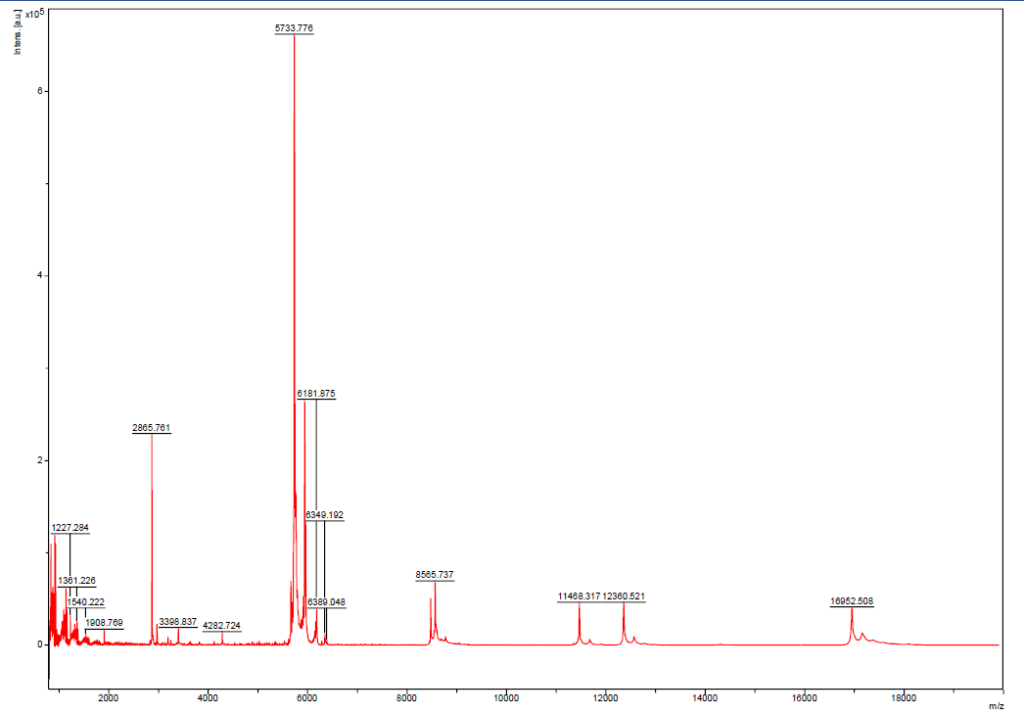 Matrix Assisted Laser Desorption/Ionization (MALDI)
Matrix Assisted Laser Desorption/Ionization (MALDI)
Overview
MALDI Analysis is a pivotal method in the field of analytical chemistry, enabling the rapid and precise determination of the molecular mass of a wide range of molecules. It has transformative applications in proteomics, genomics, pharmaceuticals, and structural biology.
MALDI Analysis operates on the principle of laser-induced ionization. It involves embedding the sample molecules of interest, such as proteins or peptides, within a matrix material. This matrix absorbs laser energy efficiently and helps desorb and ionize the analyte molecules.
When a pulsed laser is directed onto the sample, it vaporizes the matrix and analyte molecules. This process generates ions, which are then accelerated into a mass spectrometer for analysis. The time-of-flight (TOF) mass spectrometer measures the time it takes for ions to travel to the detector, allowing for precise determination of their mass-to-charge ratio.
MALDI Analysis excels in its ability to provide high-resolution mass spectra, making it invaluable for identifying and quantifying biomolecules, small organic compounds, synthetic polymers, and more.
Outermost Technology’s MALDI Analysis services offer exceptional capabilities for studying complex mixtures of molecules, elucidating protein structures, and conducting biomarker discovery. Whether you are unraveling the mysteries of molecular biology, characterizing synthetic polymers, or exploring the world of organic chemistry, our state-of-the-art MALDI equipment and experienced analysts are here to support your material characterization needs.
Services
- MALDI
- MALDI-TOF
Pricing
- Expedited service: Starts from $300 per sample with 4 – 6 days turnaround.
- For a comprehensive overview of our pricing structure, please log in to the Bee Portal.
Equipment
Bruker ultrafleXtreme MALDI-TOF/TOF Mass Spectrometer
- Bruker’s patented innovative smartbeam-II laser enables high data acquisition speed in both MS and MS/MS at full systems performance. The well-established proprietary smartbeam-II laser provides unprecedented analytical and matrix flexibility in workflows from protein tissue imaging, intact proteins analysis, glycoproteomics, biologics or oligo QC, polymer analysis, to LC-MALDI proteomics and TLC-MALDI – all fully enabled at 1-2000 Hz repetition rates.
- Broadband mass resolving power up to 40,000 enables precision proteomics via Bruker’s unique PAN technology for highest mass resolution across a very broad mass range, not just at a selected optimum.
- The FlashDetector combined with a 5 GS/s 10-bit digitizer and latest advances in electronics provide mass resolving power up to 40,000 and 1 ppm mass accuracy for highest confidence.
- The IR-laser based self-cleaning ion source ensures robust, long-term highest-performance operation. Very long MALDI laser lifetime in combination with automated source cleaning in just minutes leads to high uptime and low maintenance costs.
- Typically, full MS/MS data sets can be acquired with up to 1000 Hz laser repetition rate from low fmol levels within seconds. The Bruker bioinformatics software is perfectly adapted to analyze and visualize the match between the raw spectra and annotated peptide and protein structures.

FAQ
A: MALDI Analysis, or Matrix-Assisted Laser Desorption/Ionization Analysis, is an analytical technique used for mass spectrometry-based investigations of molecules. It enables the determination of the molecular mass of a wide range of compounds, including proteins, peptides, small organic molecules, and polymers.
A: MALDI Analysis works by embedding sample molecules within a matrix material. When a pulsed laser is directed onto the sample, it vaporizes the matrix and analyte molecules, generating ions. These ions are accelerated into a mass spectrometer, where their time-of-flight (TOF) is measured, allowing for precise mass determination.
A: MALDI Analysis provides information about the molecular mass of the sample molecules. It can identify and quantify compounds and is particularly useful for protein identification, structural characterization, and biomarker discovery.
A: MALDI Analysis can be applied to a diverse range of molecules, including proteins, peptides, nucleic acids, carbohydrates, lipids, small organic compounds, synthetic polymers, and more.
A: Outermost Technology’s MALDI Analysis services offer precise mass spectrometry-based analysis for a wide range of molecules. Whether you are conducting biomarker discovery, studying complex mixtures, or characterizing synthetic compounds, our advanced equipment and experienced analysts provide valuable insights.
A: The advantages of MALDI Analysis include high sensitivity, rapid analysis, the ability to analyze complex mixtures, and the potential for high-resolution mass spectra. It is widely used in proteomics, genomics, pharmaceutical research, and structural biology.
A: MALDI Analysis is used in various industries, including life sciences, pharmaceuticals, biotechnology, clinical diagnostics, materials science, and chemistry. It plays a crucial role in molecular research and product development.
A: In proteomics research, MALDI Analysis is instrumental for identifying and characterizing proteins, studying post-translational modifications, and discovering biomarkers associated with diseases.
A: Yes, MALDI Analysis is used for characterizing synthetic polymers, including determining their molecular weight and structure. It aids in polymer research and quality control.
A: In pharmaceutical research, MALDI Analysis helps in drug discovery, formulation analysis, and the study of drug interactions with biomolecules. It aids in understanding the pharmacological properties of compounds.

